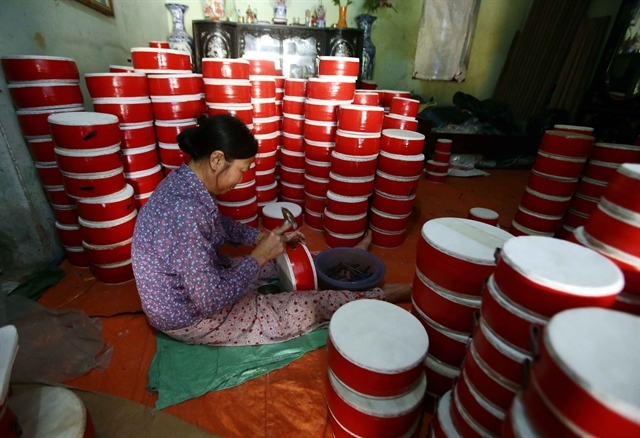Though imported plastic toys in a host of colours, designs and sizes fill most supermarket shelves, traditional toys, which once were considered at risk of fading away, remain quite popular among many kids.

Somewhere out in the countryside and even in certain corners of cities are people working hard to preserve a part of VIetnam’s cultural identity by making traditional toys, which then head to markets for sale.
Many of these people are accurately described as artisans, given their high skills in a trade that has been passed down through generations.
These artisans work at their homes in handicraft villages or in co-operatives. Such villages are well-known around the country and include Xuan La, Van Canh and Hong Ha in Hanoi, Ong Hao in the northern province of Hung Yen, and Binh Thuong B in the Mekong Delta city of Can Tho.
Fully hand-made from simple, nature-friendly materials, these toys continue to be popular with kids during traditional festivities, especially the Mid-Autumn Festival.
They include to he (toy figurines) made of glutinous rice dough; den ong sao (star-shaped lanterns) and dieu giay (paper kites) made of bamboo, colour paper and cellophane; mat na chu Teu (Uncle Teu's face masks) made of papier-mâché; trong (drums) made of wood and cattle hide, and thien nga bong (cotton swans) made with bamboo and cotton.
Despite COVID-19 making its presence felt around VIetnam, artisans remain passionate about their craft and are hard at work making sure kids have a festival full of joy and good memories, just like every other year.
Among them are members of one family living on the third floor of a small house in Hang Luoc Street in central Hanoi, who have preserved their traditional toy-making craft for decades.
They are now busy once more making toys that will be sold both before and during celebrations.
One of the artisans, Quach Thi Bac, said July and August are the busiest months for the craft, especially cotton swans, which have long been a favourite of little girls.
Her mother-in-law, artisan Vu Thi Thanh Tam, has been making toys for nearly 70 years, and still helps Bắc with some of the work.
Tam is quite well-known in toy-making circles and has been featured in the media many times, including in VIetnam News. Health problems have now slowed her down, but thankfully she has passed on the trade to the family’s younger members.
Before making a toy cotton swan, Bac explains, she prepares all the necessary materials, such as woven bamboo baskets, cellophane, sponges, metal wires, and, especially, the cotton. It takes more than an hour to finish one item, so she spends a great deal of time on the job.
As the finer points of making a handicraft toy require a subtle touch, the most important thing is patience and attention, she says.
A basket bearing two lovely cotton swans and colourful flowers is always an attraction when special times for kids roll around, and are when Bac sells from her doorstep on Hang Luoc Street. Her creations are so popular that she always sells out several days before any event starts.
Despite there being a large amount of imported Chinese toys found around the country, she says, hand-made traditional Vietnamese toys have a special reputation domestically and even overseas.
“That makes me wish I could continue to make toys forever,” Bac says. “I have a passion for my cotton swans, and would be devastated if the skill was ever lost.”
Many artisans are not only hard at work making toys for local sale but also for many friends around the world.
Nguyen Huu Kiem from Ba Duong Noi Village in Hanoi has spent nearly 60 years of his life making traditional kites, called dieu sao (flute kites).
Flute kites can be readily found around VIetnam’s north, in places such as Hai Phon City and Nam Dinh and Thai Binh provinces, with the craft stretching back to the 15th century in the latter.
Kiem has introduced flute kites and the Vietnamese way of flying them in countries such as France, Germany, Spain, Thailand, Singapore, Malaysia, and China.
His kites have appeared at major events around the world and in VIetnam, including a large kite festival in France in 2012, annual international kite festivals in Vung Tau in the south, and, in particular, celebrations for the 1000th anniversary of Hanoi in 2010.
He believes traditional Vietnamese toys like kites deserve to be preserved as part of the national cultural identity.
“Flute kites are worthy of the respect given them by international friends and should be preserved, because they ‘convey’ the soul of their makers in particular and the Vietnamese people in general,” Kiem says.
Creating a traditional kite involves a range of complicated steps. Among the first is crushing green persimmon for resin, to make the kites waterproof.
To make durable kite strings, meanwhile, artisans split bamboo into thin strips before boiling and soaking them in baked-limestone water, so they can resist white ants.
A kite needs to be at least a metre in length to be able to carry a flute made of bamboo and jackfruit wood.
Meanwhile, Dong Khe Village, by the Duong River in the northern province of Bac Ninh, is home to famous artisan Phung Dinh Giap, aged 69, who is among the last people skilled at making phong dat (folk earthen statuettes), which are made of clay in the shape of human or animal characters from folk tales.
In recent years, Giap says, whenever the Mid-Autumn Festival approaches, his family has maintained the tradition of making clay statuettes despite such toys losing their appeal among many kids.
“We are the only ones making these toys and will never stop, because we wish to preserve our traditions,” Giap says.
“I can’t accept that part of my ancestors’ heritage could disappear. Clay statuettes are part of our culture.”
He adds that while more and more people have taken a liking to imported toys, many still prefer his creations and he hopes a return to popularity is on the horizon.
Nguyen Hoang Quan, 38, a customer from Hoàng Mai District, says everyone in his family prefers traditional toys over newer types.
“My son and I like to fly flute kites, while my wife and daughter have an eye for handicrafts made by Vietnamese artisans,” he says. “We really don’t care for plastic imports.”
While Quan often gets together with friends to fly kites at the My Dinh Stadium in the summer and autumn, his children plan to buy star lanterns and paper masks at Hang Ma Street to celebrate the Full-Moon Festival.
Folk toys and handicrafts are seen more often at cultural events these days and have a certain appeal among domestic and foreign visitors alike. Cultural authorities and organisations around VIetnam are also trying to promote and preserve handicraft villages that produce traditional toys.
Beyond simply being toys, though, traditional toys convey the image and soul of the Vietnamese people and lives lived over many generations, cultural experts have noted.
Each toy is the crystallisation of the hard work and passion of artisans, many of whom now focus on preserving their time-honoured occupation.
VNS

Yen Bai to host Mu Cang Chai Terraced Field Festival
Activities to mark the National Day (September 2) and the Mu Cang Chai Terraced Field Festival is scheduled to take place in the northern mountainous province of Yen Bai between August 29 and October 18.

Opening time for Hue Festival 2020 adjusted
The Hue Festival 2020 will open on August 26 this year, two days earlier than the previously-decided date of August 28, the festival organising board said on July 21.